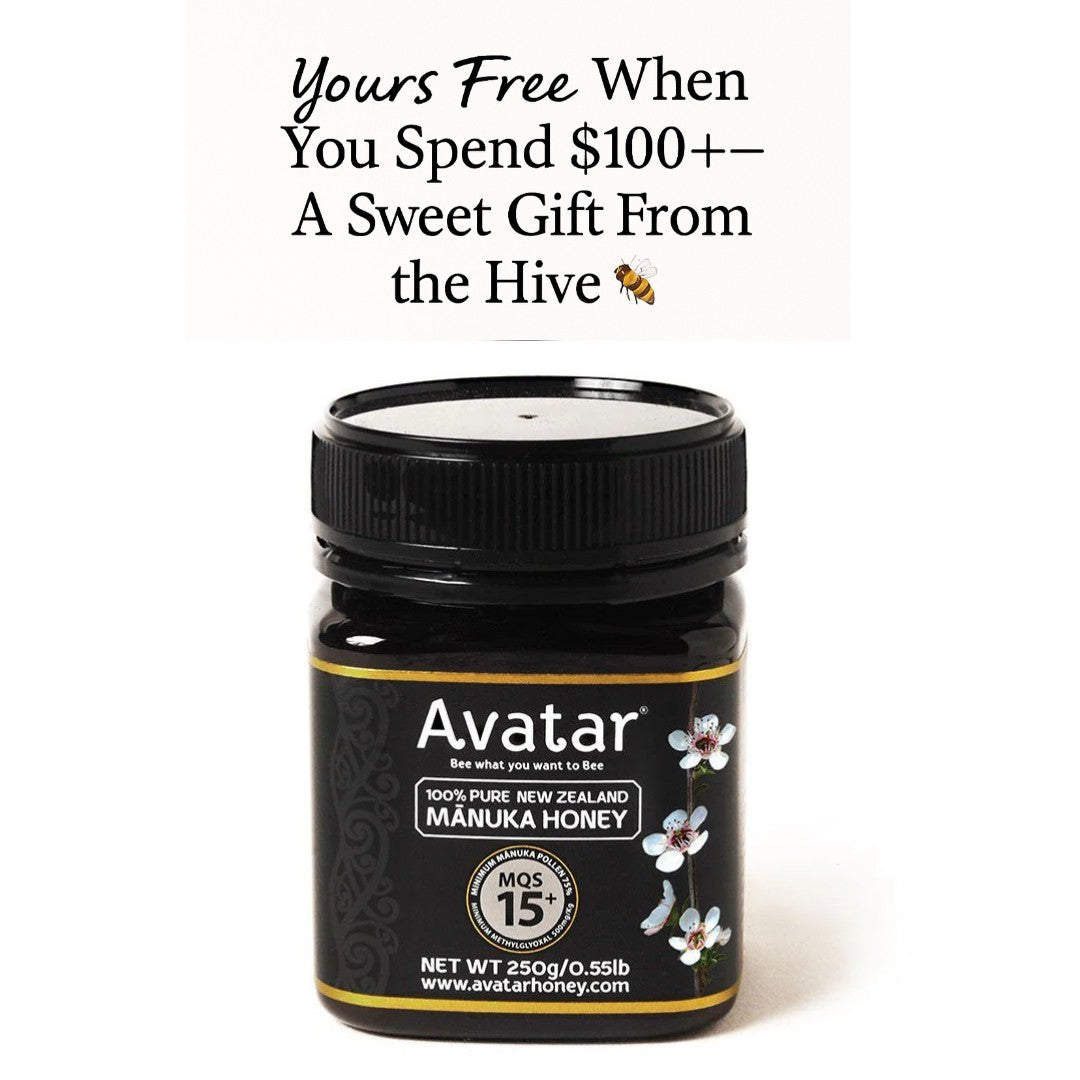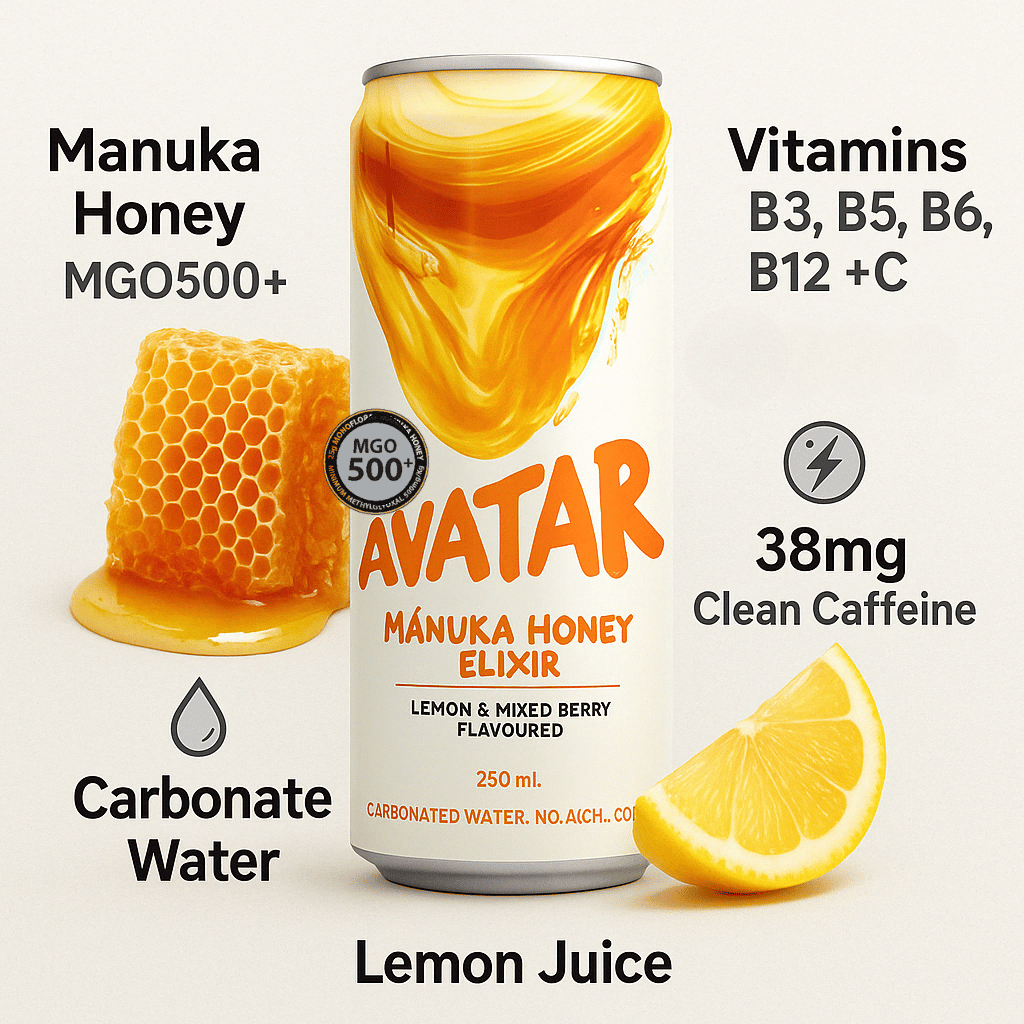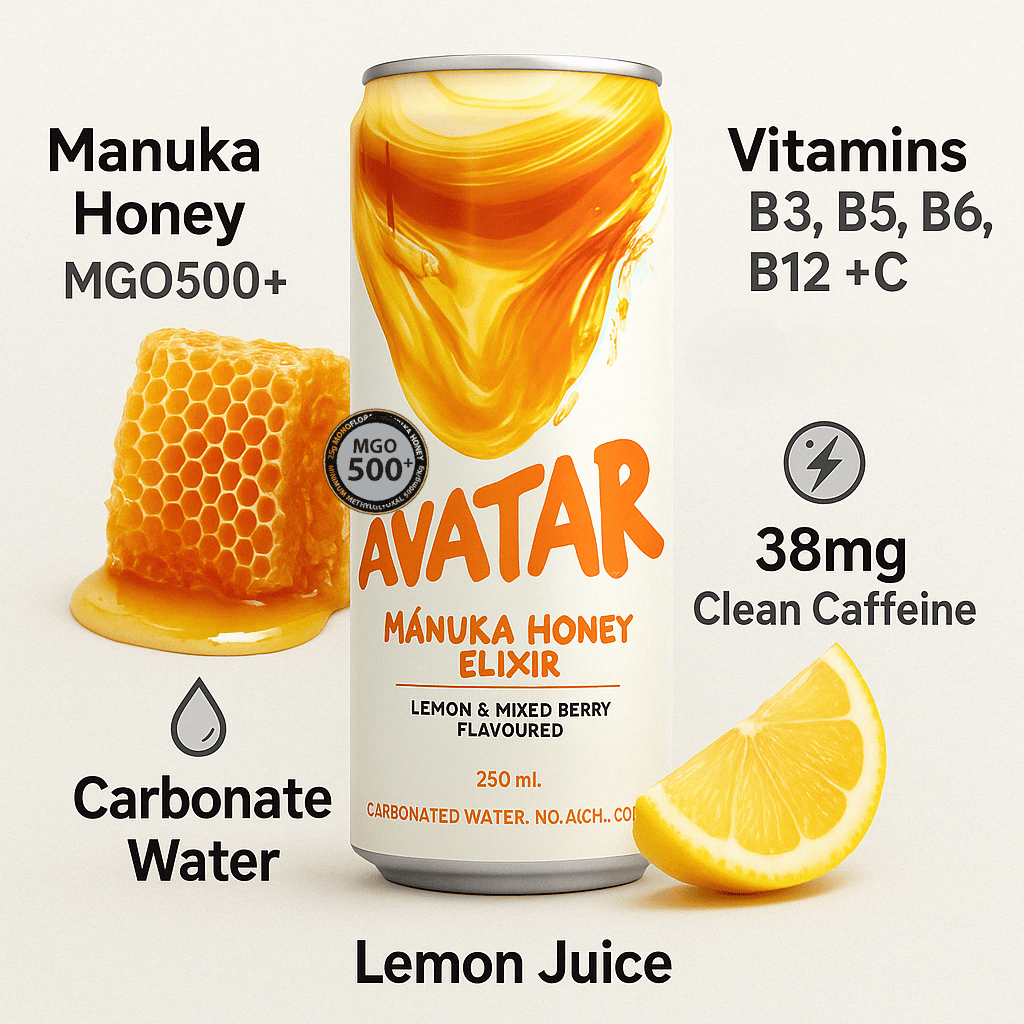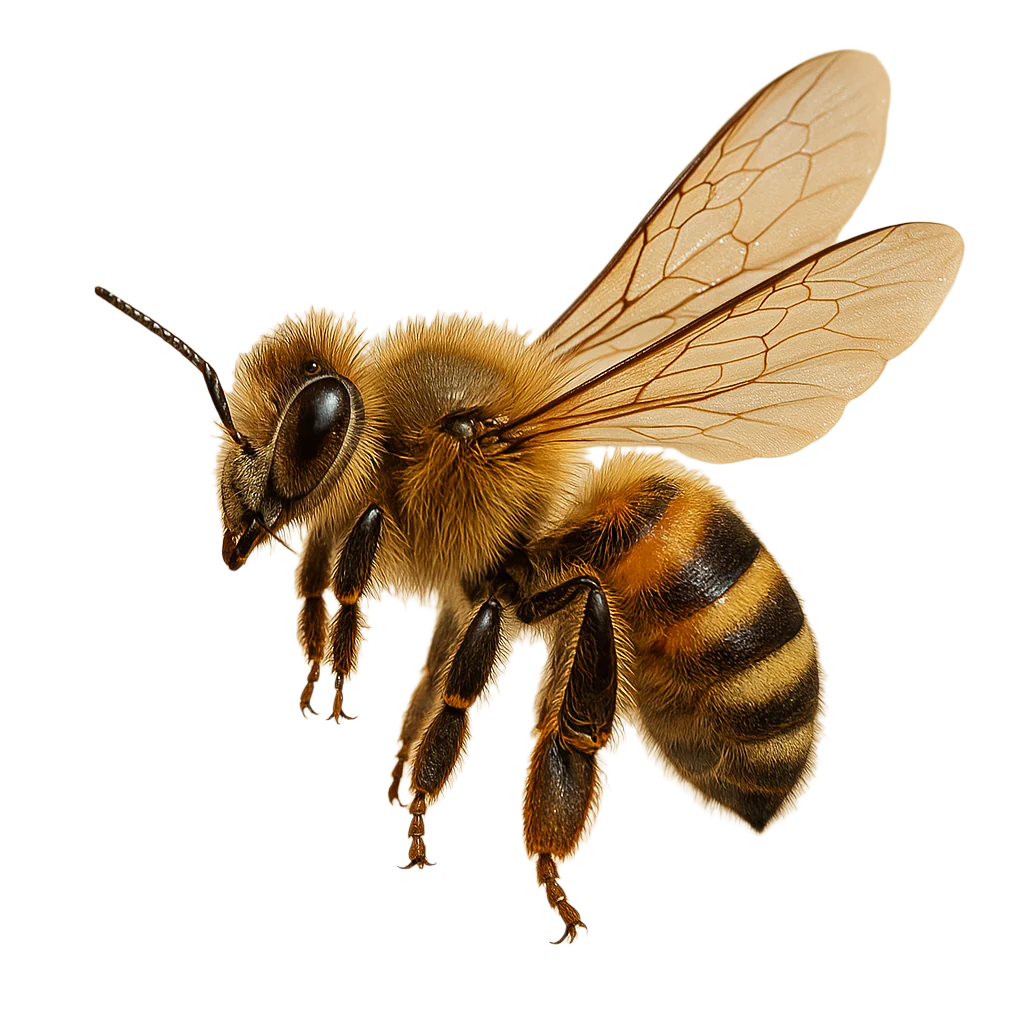For thousands of years, honey has been more than just a sweetener. It's been revered as medicine, ritual offering, and survival food treasured across cultures, continents, and civilizations. In this deep dive, we trace the golden thread of honey’s story from prehistoric cave art to modern wellness elixirs, exploring how this natural substance became woven into the fabric of human health, history, and culture.
Table of Contents
🐾🍯 Prehistoric Honey Hunters
The story of honey begins long before recorded history. The oldest known depiction of humans harvesting honey dates back some 8,000 years, found in Mesolithic rock art at the Cueva de la Araña (“Spider Cave”) in Valencia, Spain. The painting shows a human figure scaling a cliff toward a beehive, surrounded by bees, with baskets in hand. This isn't just primitive art it's evidence of an ancient, purposeful relationship with wild honey.
In the era before farming, early humans were skilled honey foragers. They sought not only honey but also wax, a valuable resource for lighting, sealing, and preserving. These wild harvests required deep ecological knowledge, courage, and patience and were often passed down through generations.
🍯 Honey as Prehistoric Superfood
To hunter-gatherers, honey was more than a sweet indulgence. It was a vital, energy-rich fuel — one of the few concentrated sources of quick-burning sugars in the natural world. Alongside its natural antimicrobial and antioxidant properties, honey also provided trace minerals and nutrients that were otherwise scarce. Some scientists even speculate that honey’s calorie density and bioactivity may have contributed to human cognitive development.
🏛️🍯 Honey in Ancient Greece and Hippocratic Medicine
To the ancient Greeks, honey wasn’t just food it was nectar from the gods. The Greek word for honey, meli, appears throughout mythology, medicine, and philosophy. Honey symbolized immortality, vitality, and divine favor.
🐝⚡ The Gods and the Bees
Greek mythology is rich with honey symbolism. Zeus, king of the gods, was said to have been nourished on honey and goat’s milk in a cave on Crete. The bee was sacred to Artemis, goddess of the hunt, and her priestesses were called Melissae — literally “bees.”
👨⚕️📜 Hippocrates and Honey as Medicine
Hippocrates, often called the father of modern medicine, prescribed honey for a range of ailments:
- Wound healing: to prevent infection and accelerate recovery
- Respiratory relief: mixed with vinegar or herbs for coughs and sore throats
- Digestive aid: to soothe ulcers and ease constipation
He believed honey helped rebalance the body’s humors and served as a powerful natural purifier.
🏋️♂️🍽️ Daily Diet and Athletic Use
Greek athletes consumed honey before competitions for energy and stamina. It was often blended into a tonic called oxymel (honey + vinegar + water), believed to boost strength and post-exercise recovery.
🎓 Philosophical Praise
Philosophers like Democritus attributed their longevity and clarity of mind to honey. It was widely viewed as a food that preserved both body and intellect.
🛡️🍯 Honey in the Roman Empire: Luxury, Medicine, and Military Rations
As the Roman Empire expanded across Europe and beyond, so did the influence of honey. From the kitchens of patricians to the battlefield tents of Roman legions, honey was a staple — not just as a sweetener, but as a medicine, preservative, and symbol of status.
🍽️🏺 Culinary Luxury for the Elite
In Roman cuisine, honey was everywhere. Wealthy households used it in moretum (herbed cheese spreads), sauces, and desserts like dulcia domestica — dates stuffed with nuts and honey. Before cane sugar arrived, honey was the go-to sweetener. It also featured in posca, a common Roman drink made from vinegar and water.
📚🧪 Medicinal Wisdom of Pliny and Galen
Roman scholars documented honey’s healing powers in great detail:
- Pliny the Elder listed over 20 uses, from sore eyes to ulcers
- Galen praised it as nutritive and purifying, recommending it both internally and externally
- Honey + vinegar: used for respiratory issues
- Honey + rose oil: applied to burns and scars
- Honey-infused wine: taken for digestion and vitality
🥾⚔️ Soldier’s Rations and Field Medicine
Roman soldiers carried honey for quick energy and battlefield healing. It was mixed with wine and herbs to create antiseptic salves for wounds. Honey’s ability to prevent infection and reduce inflammation made it a critical tool in early combat medicine.
🐝💰 Beekeeping and the Roman Economy
Honey production was a respected trade. Beeswax and honey were traded empire-wide, used in temples, taxes, embalming, and daily life. Many Roman estates had their own apiaries, showing just how essential beekeeping was to the Roman economy and culture.
🇮🇳🍯 Honey in Ancient India: Ayurveda’s Golden Gift
In the ancient Indian system of medicine — Ayurveda — honey is not just a sweetener, but a “Yogavahi”: a substance believed to carry the benefits of other herbs deep into the body’s tissues. For over 3,000 years, it has played a sacred and healing role in Indian life.
🌿📖 Ayurveda: The Science of Life
Ayurvedic texts like the Charaka Samhita and Sushruta Samhita detail honey’s unique ability to balance the three doshas (Vata, Pitta, and Kapha) when used correctly. It is classified as:
- Light and dry – for Kapha imbalances
- Sweet and astringent – supportive for healing wounds and ulcers
- An “Anupana” – a vehicle for delivering herbal medicine more effectively
🌞👨⚕️ Daily Use and Traditional Remedies
In Indian households, honey was used in:
- Morning tonics with lemon and warm water to aid digestion
- Soothing herbal teas for cough and cold relief
- Topical salves for burns, cuts, and even acne
It was often combined with herbs like turmeric, tulsi (holy basil), and ginger, creating powerful, natural remedies still used today.
🔱🙏 Spiritual and Ceremonial Uses
Honey also held spiritual significance. In Hindu tradition, it's one of the five sacred elixirs of immortality, or Panchamrita, used in temple rituals and anointing ceremonies. Babies were given a tiny drop of honey as part of a ritual called Jatakarma to welcome them into the world, believed to bless them with sweetness in speech and spirit.
🍃🧡 Legacy of Healing
Today, Ayurvedic practitioners still recommend raw honey for everything from boosting immunity to calming allergies. This ancient wisdom is now backed by modern science, reinforcing honey’s place as one of nature’s most trusted remedies.
🇨🇳🍯 Honey in Ancient China: A Tonic of Longevity and Balance
In Traditional Chinese Medicine (TCM), honey, known as feng mi (蜂蜜) — has been used for more than 2,000 years as both a food and a medicine. Revered for its harmonizing properties, honey was believed to nourish the Spleen, moisten the Lungs, and calm the Heart.
☯️ Harmony and Healing in TCM Philosophy
According to ancient TCM texts, honey belongs to the sweet flavor profile, which is thought to have tonifying, harmonizing, and moistening effects. These attributes make it especially useful in treating conditions like:
☯️ Balancing Yin and Yang
Honey was believed to support Yin energy, making it ideal for dryness, inflammation, and fatigue. It was commonly prescribed for chronic coughs, sore throats, constipation, and sluggish digestion, often taken with warm water or herbal teas.
📜 Common Prescriptions in Ancient Texts
- Honey + Chrysanthemum: to clear internal heat and soothe sore eyes
- Honey + Licorice Root: to calm the stomach and ease pain
- Honey in teas or porridge: for daily vitality and longevity
- Dry coughs and throat irritation
- Digestive imbalances, including constipation and stomach ulcers
- Restlessness and insomnia due to Qi imbalance
🌿🧘♀️ A Daily Tonic for Vitality
Chinese healers prescribed honey in warm teas and herbal mixtures to support digestion, immunity, and overall Qi (life force) flow. It was often mixed with ginseng, licorice, or ginger — creating potent, nourishing remedies.
Laozi, the famed philosopher and founder of Taoism, reportedly consumed honey regularly, believing it supported long life and a calm mind.
✨🍵 Beauty, Skin, and Longevity
Honey wasn’t just for internal wellness, it was a staple in beauty rituals too. Empresses and nobles used honey-infused masks to soften skin, reduce inflammation, and enhance radiance. Ancient beauty scrolls described honey as “a golden dew of life” for maintaining youthful vitality.
🏮 A Legacy in Modern Chinese Wellness
Today, honey remains a cherished natural remedy in China. Whether in traditional herbal pharmacies, family recipes, or modern wellness brands, its ancient role as a harmonizer, moisturizer, and immune ally continues to thrive.
🇪🇬🍯 Honey in Ancient Egypt: Nectar of the Gods
In ancient Egypt, honey wasn’t just food, it was sacred. Egyptians called it the “nectar of the gods,” and their reverence for bees ran so deep that beekeeping was depicted in temple art and papyrus scrolls.
Hieroglyphs from as early as 2400 BCE show beekeepers using smoke to calm bees, harvesting honey from clay hives — remarkably similar to modern techniques. Honey wasn’t wild; it was cultivated, controlled, and treasured.
🍯 Roles of Honey in Egyptian Society
- Medicine 🏥: The Ebers Papyrus, one of the oldest medical texts in existence, lists honey in over 500 remedies. It was used to treat wounds, burns, eye infections, digestive issues, and more.
- Preservation 🕯️: Egyptians used honey to embalm the dead. Its antimicrobial properties helped preserve the body, and its symbolic purity was thought to aid in the journey to the afterlife.
- Religion & Ritual 🛕: Honey was offered to the gods in temples. Pharaohs were buried with pots of honey, and it was often used in spiritual anointing and rites of passage.
- Cosmetics 💆♀️: Cleopatra herself was said to have bathed in honey and milk, a luxury blend meant to soften skin and preserve beauty.
For the ancient Egyptians, honey bridged the gap between the human and the divine. This golden elixir wasn’t just sweet, it was considered holy, a gift from the gods. In Egyptian mythology, bees themselves were said to spring from the tears of the sun god Ra, their honey a literal bounty from heaven.
🏥⚱️ Healing and Embalming in Ancient Egypt
Egyptian healers were among the first to harness honey’s medicinal power. Ancient medical texts, like the 16th-century BCE Ebers Papyrus — list hundreds of remedies featuring honey.
They applied it to wounds and burns to prevent infection and speed healing, centuries before modern science explained honey’s natural antibacterial properties. Even then, its ability to stave off decay was nothing short of mysterious.
Beyond the clinic, honey played a sacred role in Egypt’s elaborate burial rituals. It was used in the mummification process to help preserve bodies for the afterlife. Sealed jars of honey were left in tombs as offerings to the departed, and remarkably, some of these ancient honeypots have been discovered still intact and unspoiled thousands of years later.
Honey’s sanctity extended into religion and magic. Priests poured honey into the mouths of sacred statues during the “Opening of the Mouth” ceremony, a rite believed to restore the senses of the dead. Some texts even suggest the soul itself was symbolized as a bee.
From palace to poorhouse, honey’s healing and preserving qualities made it indispensable in daily Egyptian life, a sweet bridge between the earthly and the eternal.
🍯💰 Beekeeping and Economy in Ancient Egypt
Cultivating bees was a respected profession in ancient Egypt. For over 4,500 years, Egyptians kept bees in clay and mud tube hives, often transporting them along the Nile to follow blooming flowers and seasonal forage.
Honey and beeswax became so valuable that they served as both commodity and currency. Workers could be paid in honey, and taxes or tributes were sometimes collected in jars of it. One New Kingdom marriage contract even included an annual honey payment promised to the bride.
Pharaohs oversaw vast royal apiaries, and the bee itself was a heraldic symbol of Lower Egypt, emblazoned on royal titles and official regalia. From sweetening cakes to embalming mummies, honey’s production was a state-supported enterprise that reflected its economic, cultural, and spiritual importance.
🍯🏰 Honey in Medieval Europe: The Sweetness of Survival and Tradition
In medieval Europe, honey remained a precious lifeline, especially in an age before cheap cane sugar. It was a staple sweetener in kitchens, a trusted ingredient in medicine, and a substance imbued with symbolic meaning in religious rituals.
Whether stored in a peasant’s pantry or a monastery’s cellar, a pot of honey could mean the difference between bland gruel and a festive treat, or between an infected wound and a healed one. This era carried forward honey’s ancient legacy, adapting it to the values, beliefs, and survival strategies of medieval life.
🐝⛪ Beekeeping and Monastic Life
Monasteries became the heart of European beekeeping during the Middle Ages. Devout monks tended hives not just to sweeten their simple diets, but to provide beeswax for church candles and to illuminate sacred texts.
Bees and honey were so integral to monastic life that many abbeys became centers of apicultural innovation. Manuscripts from the time show monks sketching hive designs and experimenting with new methods to better care for their bees.
Monastic honey served many roles: it was brewed into mead for pilgrims, used in medicinal tonics for the infirmary, and given to the poor as charity. Mead — often called the “drink of the gods” was especially popular in regions where grapes for wine were scarce.
Through patient observation and stewardship, monks became the era’s master apiarists. Their care helped preserve the ancient art of beekeeping and ensured a steady flow of honey and wax that sustained both physical needs and spiritual life.
💊🌿 Medicinal Uses and Folk Remedies
Medieval healers and folk doctors prized honey as one of nature’s most versatile remedies. Though they didn’t understand antibacterial properties in modern terms, they saw honey’s ability to clean wounds, fight infection, and soothe pain.
Village wise-women would smear honey on cuts and burns, noting it helped wounds heal with less scarring. For coughs and throat infections, honey was combined with herbs like thyme or sage to make soothing syrups and lozenges.
One popular remedy was oxymel a blend of honey and vinegar, passed down since antiquity and sold in medieval apothecaries to treat coughs and fevers. Physicians also mixed honey with herbs, garlic, or spices to make balms and tonics, relying on honey’s preserving power to extract plant virtues.
Today, we know honey and vinegar (as in oxymel) have synergistic antibacterial effects, validating centuries of folk wisdom. Whether for a stomach ache, sore throat, or skin infection, medieval medicine often began with a spoonful of honey, and more often than not, it worked.
🎉🍽️ Culinary Tradition and Festivities
In the Middle Ages, honey was more than just a sweetener, it was a centerpiece of celebration and ritual. From honey cakes to barley ale, it brought richness to festive tables and symbolic meaning to everyday meals.
Honey sweetened cakes, breads, and ales, especially during holidays and religious feasts. Kitchens brought out their precious reserves to bake spiced honey loaves for Christmas or harvest festivals. Honey’s sweetness symbolized fertility, prosperity, and divine blessing.
One enduring tradition is the “honeymoon” named after the medieval custom of gifting newlyweds a month’s supply of mead (honey wine) to ensure a fruitful marriage. For that first “moon” after the wedding, couples would drink mead nightly, believing it would bring luck and children.
Spring festivals featured honeyed ale to celebrate life’s return after winter. Even Christian monks invoked honey’s symbolism, comparing scripture’s sweetness to honey, and likening the Virgin Mary’s purity to the work of bees.
To taste honey during a special occasion was to partake in something sacred. It elevated the ordinary, bringing a golden glow of meaning to food and life alike.
🍯💰 The Price of Gold
Honey’s high regard in medieval Europe wasn’t just symbolic, it was literally worth its weight in gold. Pure honey was so valuable that it often served as barter or payment, sometimes on par with imported spices.
Nobles and merchants paid dearly to stock it, while commoners often went without. Some rural families kept a hive or foraged wild honey, risking stings and danger just for a few precious combs.
Those who couldn’t access honey settled for boiled fruit syrups or malt sweeteners. Yet honey still functioned as currency in manorial records, with taxes and rent sometimes paid in beeswax or honeycomb.
Its rarity only deepened its mystique. A small jar of honey might be stretched over weeks, saved to heal a sick child or sweeten a holiday loaf. In every sense, honey carried both practical and emotional value, earning its reputation as nature’s golden treasure.
🧪🍯 Honey in Early Modern Science and Medicine: From Folk Wisdom to Laboratory Insight
During the Renaissance and into the early modern period, honey’s role began to shift, from a traditional folk remedy to a subject of scientific inquiry. Alchemists, natural philosophers, and early physicians sought rational explanations for the cures passed down through generations.
Honey remained a beloved household sweetener and cure, but now it also caught the attention of researchers working in the early laboratories of the 17th and 18th centuries. It stood at a crossroads of tradition and science with old remedies affirmed, tested, and refined through new knowledge.
👨⚕️📜 From Paracelsus to the Physicians of the Enlightenment
Renowned Renaissance physician Paracelsus (1493–1541) described honey as a near “universal medicine,” noting how it seemed to harmonize with the body’s natural processes a view that matched his belief in healing through nature.
As Europe transitioned into the Enlightenment, doctors began to document their treatments more rigorously. Honey featured prominently in medical texts and pharmacopoeias of the time. Recipes included:
- Expectorant syrups for coughs
- Digestive tonics with honey, citrus, and herbs
- Wound salves combining honey with turpentine or egg yolk
- Electuaries powdered herbs blended into a honey paste
Physicians would often quote ancient authorities like Hippocrates or Galen on the virtues of honey, then offer their own case studies showing improved recovery when honey mixtures were used. Its soothing and preserving properties made honey the ideal carrier for medicinal compounds.
By the 18th century, honey was found in both aristocratic medicine chests and rural midwives’ birthing kits. Even as chemistry advanced, isolating active plant compounds, honey held its place as a trusted, effective natural remedy, a powerful symbol of the continuity between folk wisdom and emerging science.
🐝🏡 Advancements in Beekeeping and Production
The early modern period brought major breakthroughs in honey production, driven by a better scientific understanding of bee behavior. Traditional skep hives, the upside-down basket type, were still common, but they had one big flaw: harvesting honey often destroyed the hive.
That changed in the 18th century when Swiss naturalist François Huber developed a “movable frame” hive that opened like the pages of a book. His leaf hive allowed beekeepers to inspect colonies and remove honeycomb without harming the bees, improving both yield and hive health.
Though Huber’s invention wasn’t widely adopted at the time, it laid the groundwork for future innovations, including the now-standard Langstroth frame hive introduced in 1851.
These innovations led to more efficient, sustainable honey harvesting. Beekeepers began recognizing the importance of the queen, the colony’s life cycle, and seasonal forage, helping them manage swarms and reduce hive losses.
Honey became more widely available, and people began to appreciate the distinct floral varieties like orange blossom and clover. Early honey cooperatives and local markets formed, bringing this “liquid gold” to more tables than ever before.
In short, the Renaissance didn’t just advance the science of honey’s healing powers, it also sparked a golden age of modern apiculture.
🧬🔍 Scientific Studies and Antimicrobial Discoveries
As the scientific revolution gained pace, researchers began asking: What exactly is honey made of? And why does it heal when so many other substances fail?
By the 19th century, chemists had mapped out honey’s primary components, sugars, enzymes, acids, and were amazed by its stability. A breakthrough came when they discovered glucose oxidase, an enzyme in honey that produces hydrogen peroxide when diluted. This reaction explained honey’s natural ability to kill bacteria on contact.
In recent decades, researchers found that some honeys — especially New Zealand’s Manuka honey had even more potent effects. In 2008, German scientists isolated methylglyoxal (MGO) as the compound responsible for Manuka’s unique antibacterial strength. Unlike peroxide, MGO is stable under light and heat, making it incredibly useful for wound healing and infection control.
This confirmed what Māori healers had long known: Manuka honey could treat infections where ordinary honey failed.
Ongoing research has revealed dozens of other bioactive compounds in honey — from anti-inflammatory flavonoids to peptides that aid tissue repair. These discoveries show that honey isn’t just a sweetener, it’s a sophisticated, natural medicine.
Today, scientists are studying how honey might inspire future medical treatments, bridging the gap between folk remedy and pharmaceutical science. It’s a perfect example of ancient wisdom proven true by modern discovery.
🍯🍞 Honey as a Food and Medicine in Everyday Life
Despite the rise of modern science in the 18th and 19th centuries, honey never lost its place in the lives of everyday people. Even as refined sugar from Caribbean cane became more widely available, most households still kept a jar of honey in the pantry, for both flavor and healing.
People drizzled honey on porridge, preserved fruits with it in “honey jams,” and baked it into gingerbread, biscuits, and rustic cakes. When illness struck, honey was often the first line of defense: a spoon in warm milk to ease a cough or calm insomnia, or mixed with vinegar to soothe a sore throat.
In fact, 18th-century home medical guides frequently recommended honey-based remedies, like oxymel (honey + vinegar) or honey and pepper for congestion. In rural areas, herbal medicine traditions stayed alive, and honey remained a key ingredient to extract and deliver healing herbs.
As apothecaries emerged, honey was never fully displaced. Early pharmacists used it as a base for pills, tonics, and lozenges, the term “lozenge” originally referred to a honey-sugar cake. Family journals and cookbooks from the 1800s contain countless “receipts” for honey water tonics, honey butter ointments, and soothin
🔬🍯 Honey in the 20th and 21st Century: Modern Science Meets Ancient Wisdom
The story of honey comes full circle in the modern era. In a world shaped by high-tech medicine and industrialized food systems, honey has re-emerged not just as a nostalgic ingredient, but as a scientifically validated, naturally powerful ally.
Researchers have spent the last century confirming what ancient civilizations sensed all along: honey is more than sweet. It’s functional. It heals. It nourishes. And it works.
This wave of validation has fueled a renaissance, one where honey is embraced not just as food, but as lifestyle. From hospital burn units to wellness cafés, it’s being used to treat, restore, and energize in ways both old and new.
At the same time, a growing desire for clean, sustainable living has cast honey in a golden light. It straddles the line between nourishment and medicine, tradition and science. In today’s world, honey has become a symbol of conscious consumption: natural, beneficial, and deeply rooted in history.
🧪📚 Scientific Validation and Medicinal Research
Modern science has thoroughly confirmed what ancient cultures intuitively understood: honey heals. Decades of research have demonstrated honey’s broad-spectrum antibacterial, anti-inflammatory, and antioxidant properties.
Laboratory and clinical studies show that honey can inhibit the growth of dangerous bacteria, even antibiotic-resistant strains. It creates an inhospitable, high-sugar environment and contains natural compounds that disrupt bacterial function at the cellular level.
Honey also reduces inflammation and swelling. When applied to wounds or consumed for a sore throat, it can ease pain and redness thanks to both its osmotic action and antioxidants that reduce oxidative stress.
Researchers have identified flavonoids and phenolic acids in honey that neutralize free radicals the unstable molecules that contribute to aging and chronic disease. This antioxidant capacity gives honey a dual role: protective and restorative.
Among the most remarkable success stories is Manuka honey from New Zealand. Long revered in Māori tradition, it underwent intense scientific study in the late 20th century. Researchers discovered that Manuka’s potency comes not just from peroxide activity, but from methylglyoxal (MGO) a compound stable even under heat and light.
This finding gave Manuka honey a rare distinction: medical credibility as a food-based remedy. Clinical trials have shown it can help clear infected wounds and speed healing even when standard antibiotics fail. As a result, medical-grade Manuka honey is now used in hospitals around the world.
Inspired by these results, scientists are exploring honey-based gels, nanoparticle-infused honeys, and other innovations in antimicrobial coatings. At the same time, honey’s prebiotic benefits and positive impact on metabolic health are being actively studied.
While more research is ongoing, the verdict is clear: raw, unprocessed honey offers genuine health benefits. In elevating honey from folk remedy to a focus of modern medical science, researchers have proven that sometimes, the oldest wisdom is still the best.
🏥🩹 Honey in Wound Care and Medical Applications
Perhaps nowhere has honey’s comeback been more dramatic, or more impactful, than in modern wound care. In an age dominated by high-tech antibiotics, it may seem surprising that hospitals and clinics are turning to an ancient remedy to treat today’s toughest wounds. But the results are undeniable.
Medical-grade honey sterilized and lab-tested is now used around the world to treat burns, ulcers, and chronic wounds that resist conventional therapies.
Special dressings infused with Manuka honey are commonly applied to surgical wounds and diabetic ulcers. The honey keeps the wound moist to support tissue regeneration, gradually releases antibacterial compounds, and forms a natural barrier against infection.
Clinical studies show that honey-based wound treatments can reduce healing time, lower infection rates, and even succeed where antibiotics fail. It’s especially effective against drug-resistant bacteria like MRSA (methicillin-resistant Staphylococcus aureus), which are notoriously hard to treat.
What makes honey so effective? It attacks pathogens on multiple fronts, through its acidity, high sugar content, osmotic effect, hydrogen peroxide, and other naturally occurring antimicrobial compounds. This multi-layered defense makes it difficult for bacteria to survive, let alone evolve resistance.
Doctors today are embracing what was once considered “old-fashioned” topical therapy. Many now prescribe honey-based gels and salves for home care, treating everything from scrapes and cuts to radiation burns and pressure ulcers.
Importantly, hospital-grade honey isn’t pulled from your pantry, it’s carefully purified and standardized for consistent antibacterial performance. But its origin is the same: crafted by bees, revered by humans.
In a time of rising antibiotic resistance, honey offers a rare gift: a natural, effective, and time-tested ally in modern medicine. It’s a beautiful full-circle moment, ancient wisdom solving modern problems, one healing wound at a time.
🍽️💪 Honey in Modern Nutrition and Wellness
Beyond clinical use, honey has earned renewed fame as a natural powerhouse of nutrition and wellness. In a world increasingly focused on clean eating, honey fits perfectly into the “clean label” trend, foods made with simple, recognizable ingredients.
Food manufacturers and health-conscious consumers alike are embracing honey as a wholesome alternative to refined sugars and artificial sweeteners. And it’s not just hype, honey offers trace minerals, enzymes, and antioxidants that processed sugar simply doesn’t.
Today, you’ll find honey in:
- Artisanal granola bars and protein shakes
- Electrolyte sports gels and energy chews
- Yogurt, salad dressings, and “healthy” desserts
For athletes, honey has become a go-to natural fuel. Studies show it performs on par with glucose gels during endurance activities, with the added bonus of antioxidant support for faster recovery.
The wellness movement has also inspired honey’s rise in supplements and herbal remedies. It’s the b
✨ Conclusion: Honey, A Timeless Gift from Nature 🍯
From prehistoric cave paintings of honey-hunters to modern hospitals treating wounds with Manuka dressings, the journey of honey is nothing short of extraordinary. Few natural substances have been so loved, for so long, across so many civilizations.
Honey has nourished us, healed us, and inspired our rituals. The Ancient Egyptians called it the “nectar of the gods.” Medieval healers used it in sacred remedies. And now, backed by modern science, honey is once again proving its power as food, as function, and as a symbol of natural wellness.
The continuity of honey’s role across wars, empires, scientific revolutions, and environmental change speaks to its timeless value. In every sense, honey is a golden thread connecting us to the earth, to each other, and to the past.
At Avatar , we carry that legacy forward in our Manuka Honey Elixir. We don’t add honey as a flavor, we build the drink around it. No shortcuts. No synthetic energy spikes. Just rare, high-grade Mānuka honey, harvested from the remote forests of Aotearoa New Zealand.
Each can is crafted to support your modern life whether you’re looking for a daily immune lift, a clean energy boost, or a soothing recovery after work, workouts, or long days.
We invite you to experience this golden gift made portable, functional, and delicious.
















